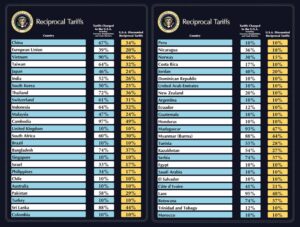The Truth Behind Tariffs: Understanding the Complexity of Global Trade

When we delve into the economic policies of the Trump Administration, one cannot ignore the contentious topic of tariffs. Specifically, what motivated the implementation of these complex tariff rates? For instance, why would a nation like Madagascar, with its modest economic footprint, face an astonishing 47% tariff? The answer lies in the contentious concept of reciprocal tariffs, which are based on America’s trade deficit with various countries.
The Mechanism of Tariff Calculation
The administration developed these tariffs by evaluating each nation’s trade surplus with the US, dividing that surplus by two, and perceiving this figure as the "fair" tariff that the US should impose. The core assumption guiding this approach is that a trade surplus indicates one country is "taking advantage" of another. However, this binary interpretation fails to capture the essence of global trade dynamics.
Trade imbalances are not merely a sign of exploitation; they represent a complex web of interconnections. For example, while China may exhibit a surplus when trading with the US, it also sources raw materials from various countries to maintain its manufacturing prowess. Therefore, imposing retaliatory tariffs could merely inflate prices for American consumers without rectifying any perceived unfairness.
The Interdependence of Economies
Let’s consider Canada, a nation significantly smaller than the US. Though it relies on America for imports, the notion that the US is subsidizing Canada through trade is a misconception. Every transaction—whether it’s a Canadian good sold in America or American products entering Canada—occurs in dollars and contributes to a broader economic relationship. This balance is vital; it’s not simply a matter of one nation benefiting at the expense of another.
In fact, trade deficits with certain countries allow the US to purchase goods that are often produced at a lower cost due to cheaper labor. Take Cambodia, for instance. The wages there are far below the US minimum wage, making production costs cheaper. After all, few Cambodians would be looking to purchase American-made automobiles, nor would local manufacturers shift operations to the US to sidestep tariffs. Instead, they would seek out buyers elsewhere, indicating that trade imbalances are a natural part of the global market.
The Ripple Effect of Tariffs
With the rising tide of tariffs, Americans may initially revel in the idea of protecting domestic industries. Yet the harsh reality is that these tariffs can lead to higher prices for consumers and increased production costs for manufacturers reliant on imported materials. The irony is clear: while tariffs are imposed to bolster American businesses, they can inadvertently constrain the very economy they aim to protect. The shrinking profit margins can lead to layoffs and an overall contraction of the workforce.
Moreover, the idea that tariffs should solely be based on a simplistic “half of the surplus” metric ignores the multifaceted nature of global economics. Tariffs are often misrepresented as reciprocal, when, in reality, they may overlook actual tariff rates imposed by other nations. The hope that international partners will willingly negotiate tariffs back to a state of free trade is naïve at best, and it often leads to a counterproductive standoff.
The Bigger Picture: Capital Flows and Stagflation
It’s important to recognize that currencies and capital flows play significant roles in determining trade balances. A surge of foreign investment in US assets—be it Treasury bonds, real estate, or stocks—can bolster the US dollar, making exports more expensive and imports cheaper. This isn’t a function of unfair trade practices but rather a reflection of the global demand for American assets.
By imposing tariffs indiscriminately, the resultant cost hike in imported goods can stifle domestic industries that depend on these imports for their products. In the end, the American consumer bears the brunt of these policies, as they face increased prices for everyday goods.
Final Thoughts
At Extreme Investor Network, we believe understanding the complexities of tariffs and international trade is crucial for making informed investment decisions. The interplay of various factors—trade deficits, currency fluctuations, and global economic interdependence—paints a picture much more intricate than simple advantages and disadvantages. As we navigate through these economic challenges, our commitment remains clear: to equip our readers with the insights and analysis needed to thrive in an ever-evolving market.
In a world where trade wars and economic policies are in constant flux, keeping your finger on the pulse of global economics will empower you to make better investment choices that weather any storm. Let’s explore the intricacies of global trade together, and ensure that you stay informed and prepared for the challenges and opportunities ahead.

